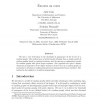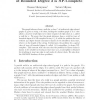29 search results - page 3 / 6 » Quasi-random graphs with given degree sequences |
COMBINATORICS
2006
13 years 5 months ago
2006
We give a new derivation of the threshold of appearance of the k-core of a random graph. Our method uses a hybrid model obtained from a simple model of random graphs based on rand...
SODA
1997
ACM
13 years 7 months ago
1997
ACM
We give a polynomial-time algorithm for the following problem: Given a degree sequence in which each degree is bounded from above by a constant, select, uniformly at random, an un...
MFCS
1995
Springer
13 years 9 months ago
1995
Springer
The graph inference from a walk for a class C of undirected edge-colored graphs is, given a string x of colors,
nding the smallest graph G in C that allows a traverse of all edge...
COMBINATORICA
2006
13 years 5 months ago
2006
We prove that the out-distance sequence {f+ (k)} of a vertex-transitive digraph of finite or infinite degree satisfies f+ (k + 1) f+ (k)2 for k 1, where f+ (k) denotes the numbe...
ALENEX
2003
13 years 7 months ago
2003
Graph models for real-world complex networks such as the Internet, the WWW and biological networks are necessary for analytic and simulation-based studies of network protocols, al...


